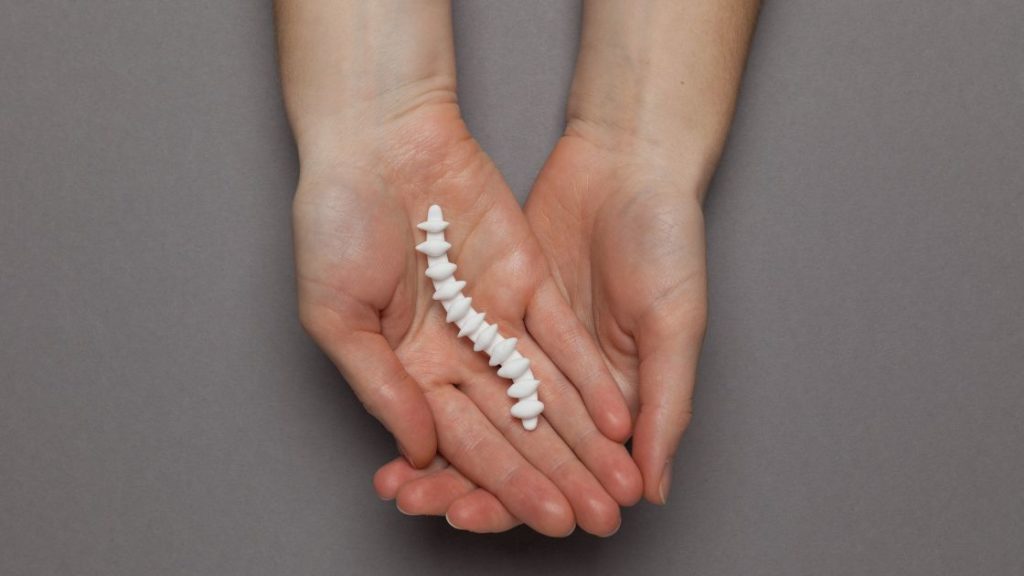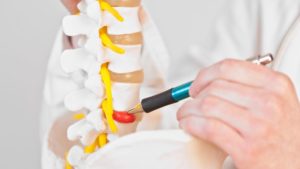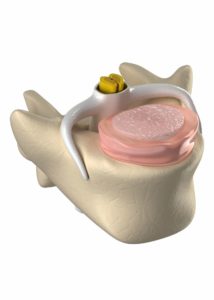Massage Therapy and Disc Injuries

Herniated discs, slipped discs, ruptured discs, bulging discs… those are four terms, often used interchangeably, to describe injuries to the intervertebral discs.
While herniated, slipped, and ruptured discs are synonymous with one another, a bulging disc is a whole other thing. Before we get into the differences between herniations and bulges, though, what exactly is an intervertebral disc?
Intervertebral Discs in a Nutshell
Or should I say… donut-shell! By looking at the picture below, you can see why intervertebral discs are often compared to jelly donuts!
An intervertebral disc is the protective cushioning between the vertebrae of your spine. The structure is composed of a fibrous outer layer made of tough cartilage, and a gel-like core made of soft cartilage. The main functions of the discs include movement of adjoining vertebral bodies, shock absorption, and nerve protection.
Herniated or Bulging Disc?
Intervertebral discs will, over time, lose fluid. When the center of a disc dehydrates and the surrounding cartilage stiffens, the circumference of the outer layer swells up. If the effects of the water loss only impact the disc’s outer layer, it is a bulging disc.
A herniated disc involves the jelly-like center of the disc. If the gel slips through a crack in its fibrous exterior casing, the disc becomes herniated (aka slipped and ruptured). Keep in mind, though, the whole disc doesn’t actually slip or rupture. Only the small crack is affected.
Aside from an aging spine, other reasons for disc injuries include poor posture, improper body mechanics, and high body mass.
Signs of a Disc Injury
As was mentioned in a previous article about spondylosis, we’re all destined to have some degree of intervertebral disc degeneration by the age of 65. The good news is that it doesn’t always present symptoms, with some people never knowing they have disc problems unless they have spinal imaging done.
With that said, here are some of the signs to be aware of if you think you may have a herniated or bulging disc:
- Sharp or dull pain
- Commonly found in the back, arms, legs, or feet
- Sciatic pain can be caused or intensified by a disc herniation near the sciatic nerve
- Pain worsens with sneezing, coughing, sitting, driving, or bending forward
- Muscular weakness and stiffness
- Muscle spasms
- Numbness and tingling
- More likely to present in the legs, but may also occur in the hands and feet
Herniated discs are more likely to cause symptoms than bulging discs. This is due to the herniated disc protruding and pressing into spinal nerves. Pain, tingling, and weakness are all common symptoms of a pinched nerve.
Massage for Disc Injuries
While direct manual pressure to the spine is contraindicated, massaging the surrounding muscular tissues can ease the symptoms of a herniated or bulging disc. In addition to relieving the discomfort, massage can also increase the chances of the disc healing on its own without invasive measures. Massage benefits such as restored joint range of motion, improved circulation, and lengthened muscular tissue all help to stabilize the area of disc bulge or herniation, which encourages the disc to move back into place.
The ideal massage for someone with a disc injury is a full-body myofascial approach to reduce pulling on the spine. Fascial restrictions compress the spine and hold it out of alignment, which can both cause and worsen disc problems.
With a disc injury, you might want to avoid trigger point therapy, as it may intensify pressure and inflammation on the discs.
At-Home Care
Attaining and maintaining flexibility is key to disc injury recovery. Be sure to do gentle back stretches on a regular basis to keep the affected disc stabilized. The best time to stretch is right after a therapeutic massage session!
Also consider heat and ice therapy as part of your treatment plan. Start with 15 minutes of heat application to loosen the muscles surrounding the disc, which will reduce pain and spasming in the area. Then follow up with 15 minutes of cold application to reduce the inflammation. Try to do that 2-4 times a day! And if you have epsom salts at home, try a warm bath to ease the discs!
Now You Know!
There is hope for your herniated and bulging discs! Get them on the right track to recovery with bodywork!

Katrina Jenkins
Author, Licensed Massage Therapist
Katrina Jenkins graduated from Towson University in 2013 with a Bachelor’s Degree in Health Science and worked as a nurse’s aide briefly before pursuing her true passion. She graduated from the Massage Therapy Institute of Colorado in April 2016 with honors and completed the Touch of Healers Scholarship Program the following summer. She has been a part of the Moyer Total Wellness Team since the summer of 2017.
Resources
Brinjikji, W., et al. “Systematic Literature Review of Imaging Features of Spinal Degeneration in Asymptomatic Populations.” American Journal of Neuroradiology, vol. 36, no. 4, 27 Nov. 2014, pp. 811–816, 10.3174/ajnr.a4173.
Ozsoy, Gulsah, et al. “The Effects of Myofascial Release Technique Combined with Core Stabilization Exercise in Elderly with Non-Specific Low Back Pain: A Randomized Controlled, Single-Blind Study.” Clinical Interventions in Aging, vol. Volume 14, Oct. 2019, pp. 1729–1740, 10.2147/cia.s223905.
Shelerud, M.D., Randy A. “Bulging Disk vs. Herniated Disk: What’s the Difference?” Mayo Clinic, 5 May 2022, www.mayoclinic.org/diseases-conditions/herniated-disk/expert-answers/bulging-disk/faq-20058428.
Waxenbaum, Joshua A, and Bennett Futterman. “Anatomy, Back, Intervertebral Discs.” Nih.gov, StatPearls Publishing, 13 Dec. 2018, www.ncbi.nlm.nih.gov/books/NBK470583/.
Photo Credit
Canva by Iryna Zastrozhnova
Canva by Jan-Otto
Canva by janulla


